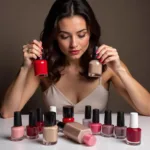Brown, a color often associated with earth, wood, and comfort, raises an interesting question: is it a cool color? The answer isn’t a simple yes or no. Understanding brown’s temperature requires delving into the complexities of color theory and its practical application in design.
Understanding Color Temperature
Color temperature categorizes colors into “warm” and “cool” groups based on their psychological associations. Warm colors like red, orange, and yellow evoke feelings of warmth, energy, and excitement, while cool colors like blue, green, and purple are associated with calmness, tranquility, and serenity. Brown, being a composite color, doesn’t neatly fit into either category.
The Complexity of Brown
Brown isn’t a primary or secondary color; it’s created by mixing various colors, often involving red, yellow, and blue. The specific proportions of these colors determine brown’s undertones and, consequently, its temperature. A brown with a higher proportion of red or yellow will lean towards warm, while a brown with more blue or green will appear cooler.
What Influences Brown’s Temperature?
Several factors influence how we perceive brown’s temperature:
- Undertones: The underlying hints of color within brown are crucial. A reddish-brown appears warmer than a greyish-brown.
- Surrounding Colors: The colors surrounding brown can also affect its perceived temperature. Placing a cool brown next to a vibrant blue will emphasize its coolness, while pairing it with warm beige will make it appear warmer.
- Lighting: The type of lighting in a room significantly impacts how we perceive color. Natural light reveals the true undertones of brown, while artificial light can either enhance or diminish its warmth or coolness.
Is Brown Ever Considered a Cool Color?
Yes, brown can be perceived as a cool color, especially when it has grey or blue undertones. These cooler browns are often described as taupe, mushroom, or driftwood. They create a sense of sophistication and tranquility, making them popular choices for contemporary interiors.
Using Cool Browns in Design
Cool browns are incredibly versatile in design. They can serve as a neutral backdrop for brighter accent colors or create a calming, monochromatic scheme. Think of a living room with taupe walls, charcoal furniture, and pops of teal or emerald green.
 Cool Brown Living Room Design Example
Cool Brown Living Room Design Example
Warm vs. Cool Browns: How to Choose
Selecting the right brown depends on the desired mood and style of the space. Warm browns create a cozy and inviting atmosphere, while cool browns offer a more sophisticated and contemporary feel. Similar to how we can determine what color floor goes with dark brown cabinets, understanding the undertones is key.
Creating a Balanced Palette
Brown, regardless of its temperature, pairs well with a variety of colors. Warm browns complement other warm hues like orange, yellow, and red, as well as contrasting cool colors like teal and navy. Cool browns create beautiful combinations with blues, greens, and greys.
Conclusion: Embracing the Versatility of Brown
So, is brown a cool color? It can be. Brown’s temperature isn’t fixed; it’s a nuanced spectrum influenced by undertones, surrounding colors, and lighting. Understanding these factors allows you to harness the versatility of brown and create spaces that are both stylish and emotionally resonant. Whether you prefer the cozy warmth of a chocolate brown or the sophisticated coolness of a taupe, brown offers a rich and diverse palette for any design project. Just like choosing what color shoes to wear with a beige dress, selecting the right brown can elevate your entire look. And similarly to the question of what color throw blanket for brown couch, understanding the interplay of colors is essential.
FAQ
- What are the most common undertones found in brown? Red, yellow, grey, and blue are common undertones.
- How can I determine the undertone of a brown paint color? Compare the paint chip to other colors, looking for hints of red, yellow, grey, or blue.
- What are some examples of cool brown paint colors? Taupe, mushroom, and driftwood are considered cool browns.
- What colors pair well with cool browns? Blues, greens, greys, and even some warmer tones like blush pink can work well.
- Can I use both warm and cool browns in the same room? Yes, but be mindful of creating a balanced and harmonious palette. Just like determining what color should your transmission fluid be requires specific knowledge, understanding color combinations is essential.
- What is the difference between taupe and brown? Taupe is generally considered a cooler, lighter version of brown, often with grey or purple undertones. Similar to how we determine what is my skin color, identifying subtle undertones is key.
- How does lighting affect the appearance of brown? Natural light reveals the true undertones of brown, while artificial light can alter its perceived warmth or coolness.
Need help with your color choices? Contact us at Phone Number: 0373298888, Email: [email protected] or visit us at 86 Cau Giay, Hanoi. We have a 24/7 customer service team.

